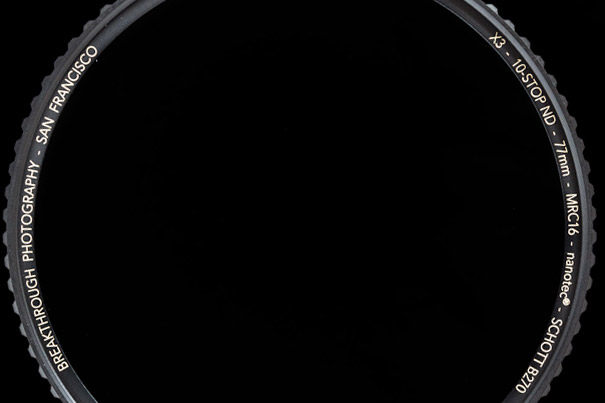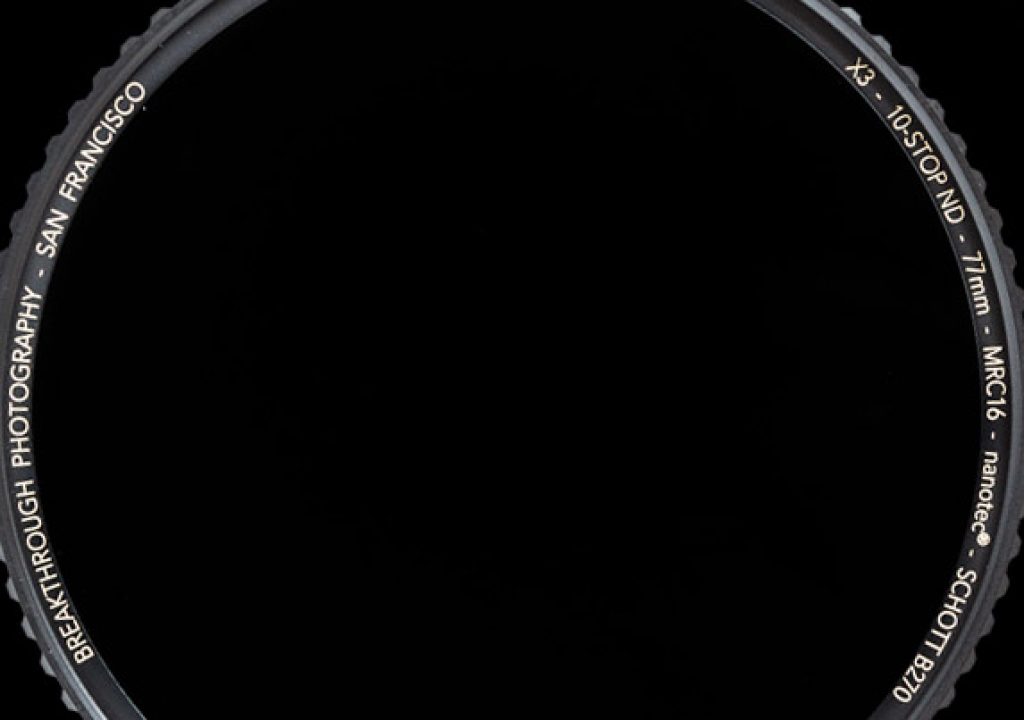
The new X3 ND 10 stop filter from Breakthrough Photography is the sharpest and most color neutral ND I’ve ever used, wrote photographer Art Wolfe when asked to try the filter. So, the claim made by the company behind this Kickstarter project seems to be right.
Art Wolfe is not alone. Bryan Carnathan, from The Digital Picture, wrote “Breakthrough sent me an evaluation filter along with some very strong claims including: The X3 ND is the world’s sharpest and most color neutral ND filter”, and ends his test with the note “turns out they were arguably right. While I have a hard time discerning any sharpness difference between the Singh-Ray and the X3 and the two are similar in color-neutralness, the X3 has far less vignetting, provides at least the 10-rated stops of neutral density and has a very significantly lower price tag. Other X3 advantages include a CNC machined brass “traction” ring (for a better grip including with gloves, avoiding stuck filters) and front threads that play well with standard lens caps and allow filter stacking.”
So, I could as well stop now, as almost everything seems to be said. But let me keep on for a little longer.This new filter really lives to the expectations created when Breakthrough Photography launched their Kickstarter campaign, which I dully noted here. Read my article New Filters are a Breakthrough in Videography.
At the time the small company declared their aim: to design and manufacture the world’s best photographic filters. At the time they promised that “if one of our state-of-the-art traction filters isn’t the best filter you’ve ever used we’ll give you a 110% refund – no hard feelings.” It seems, knowing what we know now, that no one will ask for a refund.
Graham Clark, from Breakthrough Photography, contacted me recently to ask if I wanted to test one of the X3 filters, and I choose the 10 stop, as it made complete sense to me. Nicely packaged as the video I created shows, the new filter is an interesting proposition for all those that need a neutral density filter for their work. After unboxing it, I tried to use it for some video and photography and settled for still images, to check for consistency of results. I tried multiple lenses from a wide-angle to a long telephoto, and a quick browse of the photos made me believe we’ve something to work with.
Looking through the viewfinder with this 10 stop ND filter on the lens, the world turns to a complete pitch dark night. If there’s enough ambient light and you wait a while to get used to the dim view, you’ll be able to see a faint image of what you’re photographing. I mean photographing, because this filter does not seem to have much use for video, unless you really want to slow down the taking speed…
It’s at times like this that we appreciate what Live View can do for us, as it allows – as long as there is light even for it to work – to “see” what the camera sees with this black filter on. When I look back some ten years and remember I thought Live View with real time simulated exposure was of no use for DSLR users, when it was introduced, I wish I had kept my mouth shut.
So, back to the filter. I chose the 10 stops instead of the 6 stop – which is also available, as is the 3 stop, and may be good choices for video – because I already have a variable density neutral filter, allegedly working in a 8 stops range, but that mostly works up to 6 stops, without getting the X in the middle of the frame, a result of the double polarization. That filter I can use for video, this one, which offers me, in fact, 4 extra stops, is mostly to use in photography.
I’ve some ND’s and also ND grads, but I do not use them much (or almost never, these days…). Working in coastal areas, if you’ve a series of filters you’ve multiple surfaces to clean, meaning you spend more time cleaning them than anything else. That’s one of the reasons why I started to use a Vario ND, which works great for many situations.
I thought I could do some comparison tests using my old filters, but I simply do not have the patience to do it and I also know what to expect from them, in terms of colour cast. So I left my old Cokin, even the professional series, alone, along with the Hitech I’ve used for some time (and I know well the colour casts from both brands…), and decided to simply explore what the X3 ND offered me. Anyway, there are already enough tests around, even showing that this new filter even beats Lee’s Big Stopper, so what was I going to say?
Instead, I decided to go out into the real world and explore the uses of the filter with the subjects I like the most. Fishermen on the cliffs are always an interesting subject. Their gymnastics over the rocks and boulders make for some good pictures, and they’re also great elements to include in landscape photos, when standing still. Like it happens – almost – in the image published (also in the video) here, taken with an exposure of 1 second at f/8, 100 ISO. Without the filter the exposure would be something around f/22 1/125 or similar, not exactly the best values to give me the result I wanted. The filter is a 10 stop ND built to show no colour cast or stray reflections. Looking at the results I achieved, this really works as promised and extends my options when using ND’s.
This is a coastal long exposure as I like to do them. With a human figure that stands almost still over a solid rock, and the waves crashing and moving about. It’s not a creamy end of the day quiet picture, it’s the Atlantic as it really is most of the time. You almost can feel the roar of the water. I appreciate this kind of result, with strong “daylight” colours obtained when the sun is still high in the sky. And that’s only possible with a ND filter like this one. Add the negligible colour cast, which can easily be corrected in post, and the apparent no sharpness loss and the X3 ND becomes an accessory always present in your backpack, for situations asking for long exposures.
I also did some non-scientific sharpness tests at home, just for the sake of seeing things with my own eyes, and the images shared here will give you an idea of what to expect. The images published show the whole chart photographed both without and with the filter on, with exposures changing from 1/25 at f/2.8 (no filter) to 30 sec f/2.8 (with filter). I corrected for white balance, but as I’ve said it is negligible, what is great considering this is a 10 stop ND. Move the mouse on the image above, to see the different photos. Then (image under) I’ve chosen a central section, not cropped, showing the differences between the photos. Remember that the online images do not really show what I saw on my monitor.
Another aspect of the filter that is also important to me is the presence of the traction frame. Here I feel like Art Wolfe, that asked, after trying the filters for the first time “Why don’t all filters have this?”. The X2 and X3 filters feature signature traction frames – texture CNC machined into the aluminium and brass, that makes it easier to attach and remove the filters than the legacy flat black frame. These filters are less prone to get stuck, simply because you’ve something to hold on firmly.
Filter thickness is another element to look at when buying filters. The X3 ND is 3.1mm on the frame thickness. According to Breaththrough Photography, their test labs demonstrated that 4.1mm is the frame thickness at which point 1-stop of light falloff occurs at 16mm or wider on full-frame wide-angle setups. Also, 3.1mm is the maximum thickness that will support double threads, meaning it will work every lens cap and filter ever made.
With the X3 ND, Breakthrough Photography set out to do the impossible: engineer a professional ND filter into the sharpest, most color neutral and durable ND ever. That meant reimagining every element to make it not only more functional but also increase it’s durability. According to the information provided, they “specifically designed the X3 ND be a workhorse ND filter for field work, built to withstand extreme wind, salt water, dust and other abrasive conditions and elements”, and they “guarantee each X3 ND to perform with optimal clarity and color neutrality for 25 years even in the harshest of conditions.”
The X3 filters are only part of the products on offer by Breakthrough Photography. The small photography filter design and manufacturing company based in San Francisco has a range from polarizers to UV, and also step-up rings, something always essential when you buy filters like the ND’s. In fact, it makes sense to buy your ND filters the diameter of your bigger lens and then buy step up rings to use the filter with other lenses.
Check Breakthrough Photography’s website for all the options available, and build your own kit.

